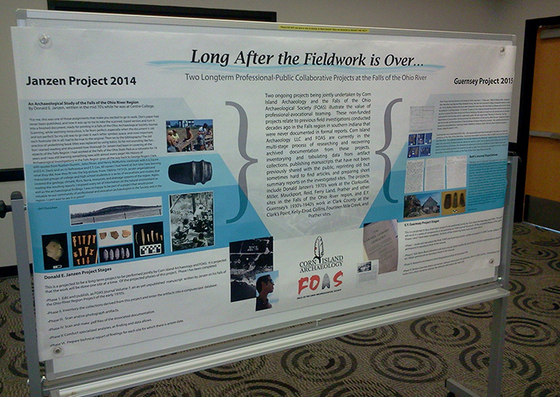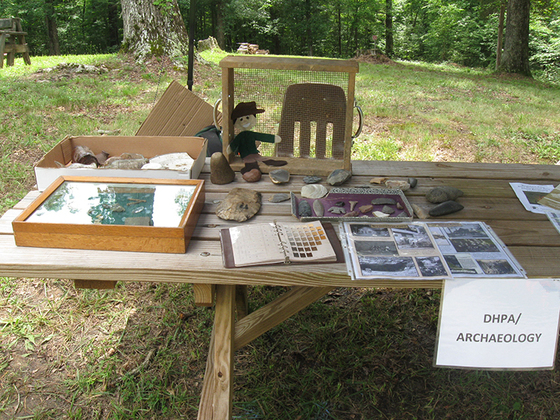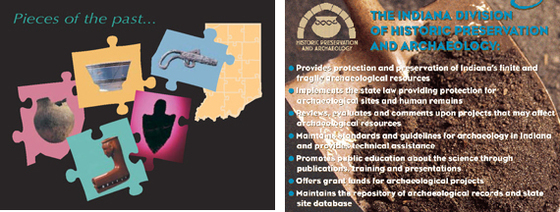|
Indiana State Fair - The Fair will run from Aug. 5-21 this year at the State Fairgrounds in Indianapolis. DHPA staff members will be involved at the Fair again this year. For example, State Archaeologist Amy Johnson will be conducting an archaeology roadshow on Saturday, Aug. 20 from 10 a.m. to noon at the front porch of the DNR building. Retired Indiana State Archaeologist Dr. Rick Jones will be volunteering that day as well. Feel free to bring an archaeological artifact for identification. No monetary values will be provided. In addition, a variety of archaeological handouts will be available to those who stop by. This free event (with State Fair admission) provides a good preview of the types of activities which will be available around the state during the following month, September, which is Indiana Archaeology Month. There will also be Archaeology Month posters, and commemorative t-shirts will be available for purchase. Learn about more DNR activities and events during the Indiana State Fair.
 |
|
Amy Johnson and Dr. Jones at the Archaeology Roadshow at a past Indiana State Fair. |
Indiana Archaeology Month - Next month is Indiana Archaeology Month, and this year the Month has been designated an official Indiana Bicentennial Legacy Project. If you have an archaeology event planned during or around September that you would like listed in the official Calendar of Events, please complete the form and submit it to our office by Aug. 8.
We look forward to the many exciting activities that will take place and hope that you will be able to join in the fun and learning. Later this month we will be sending out information regarding the availability of the 2016 commemorative posters and shirts.
Call for Papers - The Division of Historic Preservation and Archaeology (DHPA) invites you to submit abstracts for the 2nd annual Indiana Public Archaeology Symposium, co-hosted by the Applied Anthropology Laboratories in the Department of Anthropology, Ball State University. We hope you will join us on Ball State University’s campus in Muncie on Aug. 27 for this free event. Topics should focus on experiences with public archaeology programs, success stories, unique strategies used to engage communities, and how technology has changed the way archaeologists interact with the public. Paper and poster presentations will be considered, so please indicate which you plan to present when you submit your abstract.
Abstracts are due Aug. 5 and should be submitted to rsharkey@dnr.IN.gov. More conference information will be announced shortly.
 One of the posters presented at last year’s Symposium.
Outreach in Whitley County - DHPA Archaeologist Wade Tharp presented “Archaeology in Your Community” at the South Whitley Public Library on July 28. The event was free of charge and open to the public.
SHAARD Tip - Check here each month for a new tip on how to use and navigate SHAARD! This month’s tip: We are chugging away and getting archaeological site forms, survey reports, and historic structures information into the SHAARD database for you. This summer alone, components of Delaware, Wabash, Howard, LaPorte, and Hamilton counties have been completed! As you do your research please keep in mind that SHAARD is a work in progress. If you ever have a question about if a county is complete, please contact Rachel Sharkey at rsharkey@dnr.IN.gov.
Wyandotte Cave State Recreation Area Grand Reopening - On July 9, DHPA archaeologist Cathy Draeger-Williams participated in this free event. Lots of interested visitors stopped by the DHPA artifact table (see below) to look at artifacts and talk about Indiana’s prehistoric and historic past and Wyandotte Cave. Cathy learned a lot too, especially from individuals that were from the area and were or related to past tour guides. One younger visitor explained archaeology to staff. There were also the birds of prey, snakes, and activities regarding wildlife, geology, forestry, and cave safety plus the dedication ceremony and free cave tours of both the Big and Little Wyandotte Cave. Learn about Wyandotte Cave State Recreation Area.

 Getting to Know the Archaeology Team - Some members of the public may not have met our staff archaeologists, or know much about them, so our next DHPA’s Archaeology Team member to be introduced is Wade T. Tharp. He graduated with a B.A. in Liberal Arts (Anthropology major, Classical Studies minor) from Indiana University (Indianapolis), and graduated with a M.A. in Historical Archaeology from Illinois State University (Normal). He answers a few questions below.
|
* How long have you worked for the DHPA, and before coming to the DHPA, what archaeological/anthropological employment experiences did you have?
I have worked for the DHPA since April 2010. Before coming to the DHPA, I worked for the Indiana State Museum as a private contractor, processing architectural artifacts; for Illinois State University as a Graduate Student Assistant in the Historical Archaeology Laboratory, and for the Illinois Transportation Archaeological Research Program.
* What are you most passionate about professionally? What most excites you about your work and the contribution you can make?
Professionally, I am most passionate about learning how culture and history are constructed, maintained, and changed; and about how anthropological practices can encourage and inform broader investigations—and deeper understandings—of culture and history.
* What is the most exciting, interesting, or challenging, archaeological project in which you have been involved?
The most interesting archaeological project with which I have been involved was my graduate field school, during which we conducted archaeological investigations on the property of the Janis-Ziegler House (a.k.a. the Green Tree Tavern) at Ste. Genevieve, Missouri.
* What are your archaeological research interests?
My archaeological research interests include critical theory in historical archaeology, the archaeology of internal colonization, and the archaeology of French vernacular architecture.
* Where can we find you when you’re not working at the DHPA? What’s your favorite way to spend a weekend?
When I’m not working at the DHPA, I can be found working in my yard and garden. My favorite way to spend a weekend is composing, recording, rehearsing, and performing music.
Annual grants to strengthen and preserve Indiana’s history have been awarded - The grants total $375,293 in federal funds allotted by the DNR Division of Historic Preservation and Archaeology. They will be matched by $360,718 in local and private funds, for a total investment of $736,011.
The funds come from the National Park Service, a part of the U.S. Department of the Interior, which distributes federal funds to the states through the Historic Preservation Fund Program. Since 1974, the state has awarded more than $18 million to Indiana communities through the program.
The archaeological projects are:
Benton County: Ball State University’s Department of Anthropology received a $49,972 grant to conduct an archaeological survey of 900 acres in Benton County.
Newton County: Ball State University’s Department of Anthropology received a $49,972 grant to conduct a survey of approximately 900 acres in Newton County. The project is intended to add to the understanding of prehistoric cultures, the Euro-American presence and Native American interaction.
Contact: Chris Keller Thompson, Ball State University, (765) 285-5328.
Tippecanoe County: The University of Southern Indiana received a $26,308 grant to conduct a non-invasive, geophysical archaeological survey and more precise mapping of Native American villages that once surrounded Fort Ouiatenon on the Wabash River in Tippecanoe County.
Contact: Dr. Mike Strezewski, University of Southern Indiana, (812) 464-1931.
Contact information:
Name: Malia Vanaman
Phone: (317) 232-1648
Email: mvanaman@dnr.IN.gov
Archaeology Site of the Month - Fort Knox II (12K327) was added to the National Register of Historic Places in 1982. The first fort was built in 1788 in Vincennes after the Northwest Territory was created in 1787 and was in use until 1803, when Fort Knox was moved farther up the Wabash River. Gov. William Henry Harrison and the commander of the fort decided on an area near a rock outcrop that had a good view both up and down the stream. Harrison moved the fort out of the city partly because the relationship between settlers and Native Americans was not as hostile and soldiers had begun harassing the citizens of the settlement. The fort was probably completed by 1804, and remained in use until 1813. Fort Knox was badly manned, with little to no discipline. After Captain Thornton Posey killed Lieutenant Jesse Jennings in 1811 as a result of a personal duel and fled to Kentucky, the fort was left without an effective commander. At this point Zachary Taylor came to take command of the fort and began to properly garrison the fort, but was reassigned not long after. In 1811, Harrison began attacking villages under the protection of the Prophet and Tecumseh. This led to more soldiers being brought to the area and increased tensions with the Native Americans. As a result, in 1813 the settlers in Vincennes decided to move the fort back inside the town to better protect them.
The Indiana Historical Society conducted investigation at the site between 1963 and 1966. Archaeologists first uncovered the location of the fort, the bastions (east, south, and west) and the stockade trenches to the southeast and southwest during the 1963 and 1964 excavations. The 1965 and 1966 seasons further defined the outline of the fort. Some of the artifacts discovered at the site include rifle flints, period bricks, glass fragments, and a chamber pot. The most interesting object was a military button that belonged to a soldier that served with the 12th regiment. Later investigations at the site include the work by Marlesa Gray in the late 1980s. She conducted and synthesized archaeological investigations at the site. The Indiana State Museum conducted archaeological investigations at the Ft. Knox II site in 2006 (Michele Greenan, Gail Brown, personal communications with Amy Johnson, 2009).
Gray, Marlesa A.
1988 Archaeological Investigations of Fort Knox II. Indiana Historical Society, Indianapolis.
Krasean, Thomas
1979 National Register of Historic Places Inventory- Nomination Form Fort Knox II Site (12K327).
Stevens, Robert R.
1968 Interest reviving in Old Ft. Knox. The Valley Advance 4(47). Vincennes University, Vincennes, IN.
Watts, Florence G.
1966 Fort Knox: Frontier Outpost on the Wabash, 1787-1816. Indiana Magazine of History 62(1):57-78.
Talk with an Expert - Archaeology Outreach Coordinator Amy Johnson will be available beginning at 2 p.m. on Aug. 31 on Facebook to answer questions about archaeology in our state and the upcoming Indiana Archaeology Month. Her session will be part of the Talk to a DNR Expert series hosted by various DNR personnel each month. During each session, a DNR employee who specializes in a specific topic will be on Facebook answering all your questions about that topic. As many questions as possible within the hour will be answered.
Participation requires a free Facebook user account. Visit and "Like" the Indiana Department of Natural Resources on Facebook. You can email questions before the talk or post questions on DNR's Facebook wall during the talk. Please use the comment feature under the expert's post instead of starting a new post. Participants should follow DNR's social media comment policy.
Amy looks forward to hearing from the public regarding questions they may have about topics such as: archaeological sites in Indiana, the laws which protect sites, Archaeology Month, and more. Advance questions can be emailed to dkrause@dnr.in.gov.
This information is distributed via email by the Indiana Department of Natural Resources, Division of Historic Preservation and Archaeology (DHPA). This is meant to provide information on current archaeological topics and issues in which the DHPA is involved. An archive of past Archaeology News issues is available. If you have any questions, do not hesitate to contact our office at (317) 232-1646.
 Division of Historic Preservation and Archaeology, 402 W. Washington St., Room W274, Indianapolis, IN 46204. www.IN.gov/dnr/historic
Indiana Archaeology Month (September) webpage - http://www.in.gov/dnr/historic/3674.htm
#INArchaeoMonth
Find the Division of Historic Preservation and Archaeology on Facebook.
Compiled by Amy Johnson, State Archaeologist, Archaeology
Outreach Coordinator, and Team Leader for Archaeology (August 2016). Text
and/or images also provided by Rachel Sharkey, Wade T. Tharp, Cathy
Draeger-Williams, Malia Vanaman, and DHPA intern Elizabeth
Flora, University of Evansville. #ArchaeoNewsIN
Mission Statement: The Division of Historic Preservation and Archaeology promotes the conservation of Indiana’s cultural resources through public education efforts, financial incentives including several grant and tax credit programs, and the administration of state and federally mandated legislation.

Having trouble viewing this email? View it as a Web page.
|